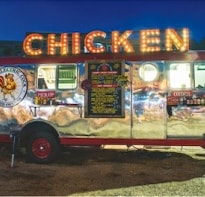Anyone for deep-fried avocado? We join a crack team of trendhunters in search of the next big foodie thing in Texas
From avocado to kimchi: a short history of fashionable foodAvocado
When small green fruits called avocado pears first appeared on supermarket shelves in the 1960s, no one quite knew what to do with them - in Manchester one woman stewed them and served them with custard. Her letter of complaint to M&S saw the retailer rebrand them and start selling them with an explanatory leaflet. Fast-forward 40 years and you can't move for guacamole and avocado smoothies.Sushi
M&S's attempts to sell it in the 1980s fell flat as consumers balked at the idea of eating raw fish. It took off in the 1990s thanks to the expansion of the Yo! Sushi chain and the opening of Nobu in London. Brits now spend about £40m on the stuff every year.Popcorn
Available in Britain for almost 100 years, but recently given a makeover. No hip party is now complete without a stall festooned with bunting and faux-Victorian signage offering popcorn in flavours such as cheese and tomato, wasabi, sea salt and olive oil, and even gin and tonic. Gourmet popcorn is so hot right now that the fact that many of these products taste like a wedge of cardboard that has absorbed the moisture at the bottom of the fridge is moot.Coconut water
No longer the bit you throw away. This milky-coloured drink is high in potassium and is a big hit with gym bunnies and models, but it has now reached corner stores and kids' lunchboxes: 39 varieties are now sold in the UK, and sales are predicted to rise to £250m by 2017.Kale
Kale - chewy and bland, but high in fibre and iron - is nothing new: it featured prominently in the Dig For Victory campaign during the second world war, but fell from favour soon after. Partly thanks to Oberon Sinclair, a canny British PR working for the American Kale Association, it has become the modern superfood of choice. Peak kale arrived when Beyoncé put a picture of herself on Tumblr wearing a "Kale" sweatshirt with 'Kale' written on it.Kimchi
This Korean fermented cabbage is part of the vogue for "partially decayed" foods that includes pickles and kombucha, a slightly fizzy fermented tea drink that is never far from Gwyneth Paltrow's fridge.One of 1,000 food trucks in Austin, Texas: 'Can I try your gumbo? I want to try the alligator, but we might have a sourcing issue back in the UK.' Photograph: Sandy Carson for the Guardian
Advertisement
Advertisement
Advertisement
Advertisement
From avocado to kimchi: a short history of fashionable foodAvocado
When small green fruits called avocado pears first appeared on supermarket shelves in the 1960s, no one quite knew what to do with them - in Manchester one woman stewed them and served them with custard. Her letter of complaint to M&S saw the retailer rebrand them and start selling them with an explanatory leaflet. Fast-forward 40 years and you can't move for guacamole and avocado smoothies.Sushi
M&S's attempts to sell it in the 1980s fell flat as consumers balked at the idea of eating raw fish. It took off in the 1990s thanks to the expansion of the Yo! Sushi chain and the opening of Nobu in London. Brits now spend about £40m on the stuff every year.Popcorn
Available in Britain for almost 100 years, but recently given a makeover. No hip party is now complete without a stall festooned with bunting and faux-Victorian signage offering popcorn in flavours such as cheese and tomato, wasabi, sea salt and olive oil, and even gin and tonic. Gourmet popcorn is so hot right now that the fact that many of these products taste like a wedge of cardboard that has absorbed the moisture at the bottom of the fridge is moot.Coconut water
No longer the bit you throw away. This milky-coloured drink is high in potassium and is a big hit with gym bunnies and models, but it has now reached corner stores and kids' lunchboxes: 39 varieties are now sold in the UK, and sales are predicted to rise to £250m by 2017.Kale
Kale - chewy and bland, but high in fibre and iron - is nothing new: it featured prominently in the Dig For Victory campaign during the second world war, but fell from favour soon after. Partly thanks to Oberon Sinclair, a canny British PR working for the American Kale Association, it has become the modern superfood of choice. Peak kale arrived when Beyoncé put a picture of herself on Tumblr wearing a "Kale" sweatshirt with 'Kale' written on it.Kimchi
This Korean fermented cabbage is part of the vogue for "partially decayed" foods that includes pickles and kombucha, a slightly fizzy fermented tea drink that is never far from Gwyneth Paltrow's fridge.One of 1,000 food trucks in Austin, Texas: 'Can I try your gumbo? I want to try the alligator, but we might have a sourcing issue back in the UK.' Photograph: Sandy Carson for the Guardian
For the latest food news, health tips and recipes, like us on Facebook or follow us on Twitter and YouTube.
Advertisement
Tags:
